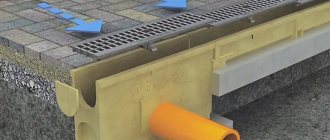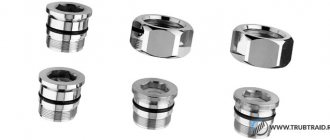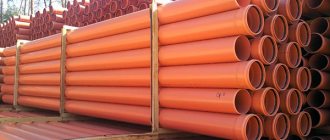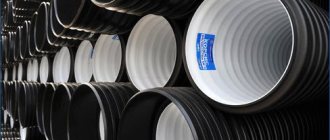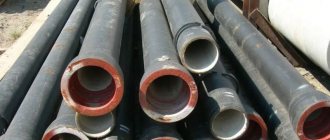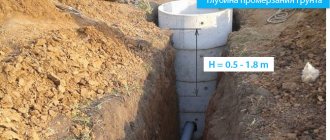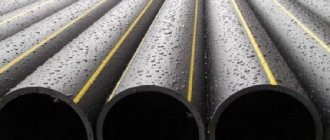One of the most important characteristics of a steel pipe is its diameter (D). Based on this parameter, all required calculations are made when designing an object. How to choose the diameter so as not to make a mistake?
The diameters of metal pipes are standardized and must correspond to the values of GOST 10704–91.
Conventionally, they are divided into several subgroups:
- Large – 508 mm and above;
- Medium – from 114 to 530 mm;
- Small – less than 114 mm.
Metal products and their outer diameters
All types of metal pipes are manufactured at the factory, based on their outer diameter “Dн”. Standard diameters are shown in the table below.
In industry and construction, they mainly use products whose diameters are in the range of 426–1420 mm. Intermediate standard sizes of water pipes are taken from the table.
Small D metal products are mainly used for laying water pipes in residential buildings.
Medium D metal pipelines are used for laying city water supply. Such water pipes are used by industrial systems involved in the extraction of crude oil.
Large sizes of steel pipelines have found application in the creation and laying of main oil pipelines. They are also used in the gas industry. Through such pipelines gas is supplied to every corner of the planet.
Types of steel pipes according to their production method
- Electric welded (straight seam)
For their manufacture, strips or sheet steel are used, which are bent to the required diameter using special equipment, and then the ends are connected by welding.
The effect of electric welding guarantees a minimum seam width, which makes it possible to use them for the construction of gas or water pipelines. The metal is in most cases carbon or low alloy.
The indicators of finished products are regulated by the following documents: GOST 10704-91, GOST 10705-80 GOST 10706-76 .
Please note that a pipe manufactured in accordance with standard 10706-26 is distinguished by the maximum strength among its peers - after creating the first connecting seam, it is reinforced with four additional ones (2 inside and 2 outside).
The regulatory documentation indicates the diameters of products produced by electric welding. Their size ranges from 10 to 1420 mm.
- Spiral seam
The material for production is steel in rolls. The product is also characterized by the presence of a seam, but unlike the previous production method, it is wider, which means the ability to withstand high internal pressure is lower. Therefore, they are not used for the construction of gas pipeline systems.
A specific type of pipe is regulated by GOST number 8696-74.
- Seamless
The production of a specific type involves the deformation of specially prepared steel blanks. The deformation process can be carried out both under the influence of high temperatures and in a cold way (GOST 8732-78, 8731-74 and GOST 8734-75, respectively).
The absence of a seam has a positive effect on the strength characteristics - the internal pressure is evenly distributed over the walls (there are no “weak” places).
As for diameters, standards control their production with a value of up to 250 mm. When purchasing products with sizes exceeding those indicated, you have to rely only on the integrity of the manufacturer.
It is important to know!
If you want to buy the most durable material, buy seamless cold-formed pipes. The absence of temperature influences has a positive effect on preserving the original characteristics of the metal.
Also, if the ability to withstand internal pressure is an important indicator, then choose round products. Profile pipes cope better with mechanical loads (metal frames, etc., are well made from them).
Here are a couple more excellent slides of creative advertising for a pipe manufacturer:
Inner diameter
This metal pipe size (Din) can have different values. Moreover, the value of external D always remains unchanged. To standardize the diameter of water supply pipes, designers use a special value called “nominal diameter”. This diameter has its own designation Dу.
In fact, the nominal diameter is the minimum value of the internal diameter of a given product, rounded to the nearest whole number. Rounding is always performed towards the maximum value only. The value of conditional D is regulated by GOST 355–52.
To calculate internal D, a special formula is used:
Din = Dn – 2S.
The internal diameters of steel products range from 6 to 200 millimeters. All intermediate values are shown in the corresponding table.
The diameter of metal pipes is also measured in inches, which is 25.4 millimeters. The table below shows the product diameters in both inches and millimeters.
Which pipe is considered small - medium - large?
Even in serious sources I have seen phrases like: “We take any pipe of average diameter and...”, but no one indicates what this average diameter is.
To figure it out, you should first understand what diameter you need to focus on: it can be internal or external. The first is important when calculating the transport capacity of water or gas, and the second is important for determining the ability to withstand mechanical loads.
External diameters:
- From 426 mm is considered large;
- 102-246 is called average;
- 5-102 is classified as small.
As for the internal diameter, it is better to look at the special table (see above).
Plastic
Nowadays, their plastic counterparts have become an alternative to metal pipes. Moreover, their sizes vary widely. The material for such a product is:
- Polypropylene;
- Polyethylene;
- Metal-plastic.
Each manufacturer of such pipes sets its own size chart. Therefore, if one system is being manufactured, it is advisable to use parts from the same manufacturer.
Of course, there will definitely be discrepancies, but they will be minimal and will not cause any particular difficulties for a good master. If a person has little experience, he will have to make some efforts to fit all the sizes.
The table of sizes of plastic pipes for water supply using polypropylene of various densities shows the most popular models.
When all kinds of communications are laid, builders also use other diameters of plastic water pipes.
The diameters of water pipes in the table help you select the appropriate product for repairs or other work.
Marking
In the construction of water supply systems, plastic and steel water pipes are actively used. Let's look at the labeling for these product options:
- PPR. The presence of such markings indicates the material from which the pipe is made. In this case it is polypropylene with rand copolymer.
- HAPPY BIRTHDAY. This is the ratio of the outer diameter to the wall thickness of the product. The lower this value, the thicker the pipe wall, the greater the strength. Such pipes are designed for high pressure systems.
- Numerical values and multiplier. The first value in the product represents the outer diameter. The second is wall thickness.
- Permissible pressure. It is rare to find a PN 20 coefficient here. It means that at a temperature of 20 °C the water pipe will maintain normal pressure for 50 years of operation.
- Manufacturing standard. Domestic manufacturers use the GOST 32415-2013 standard.
The steel water pipe has its own marking.
For example, on the surface of a water pipe there may be the letter “P”. This means that this is a pipe of increased strength. In the case of the letter “U”, we are talking about a reinforced structure. The letter “L” stands for lightweight water pressure element. If the marking contains the letter “C”, then we are talking about galvanized water pipes.
Cast iron
Such products are used for installing water supply systems outside the building. In residential premises, cast iron water supply is installed extremely rarely. This material has high strength, but increased fragility. Its main disadvantage is its heavy weight and high cost. The operation of such cast iron products is designed for many years.
To compare the sizes of cast iron plumbing products, below is a table showing the dimensions of Class A cast iron pipe.
Diameter and weight of cast iron pipes.
Nowadays, water supply systems made of cast iron pipes are practically not applicable in apartments. The main reasons: great fragility and very heavy weight. At the same time, due to the durability of the material, cast iron water pipes are laid in external conditions.
From this table you can find out how much a cast iron pipe weighs:
Table of diameters of cast iron water supply pipes
How to convert inches correctly
There are special tables for such calculations. Let's take, for example, a pipe with D = 1″. The outer diameter of the water supply pipe will not be 25.4 mm. The cylindrical pipe thread has an outer D = 33.249 mm. Why is this happening?
Thread cutting is performed only on the outer diameter. Consequently, the value of the nominal diameter of the cut thread in relation to the internal value becomes conditional. To calculate the diameter of a water supply pipe, you need to take 25.4 mm and add the wall thickness multiplied by 2, you get 33.249 mm. The conversion of inch values of water pipe diameters to mm can be found in the table below.
Standard diameters of steel pipes on the table with wall thickness and weight regulated by GOST. (For water pipes.)
Steel water and gas pipes (extract from GOST 3262-75)
Conversion table for water pipe diameters from inches to millimeters
Conversion table for inches to millimeters
Classification of water pipes
Historically, measurements were calculated in inches. This meaning differed in each state. It was conventionally equated to:
- the width of the index finger;
- the length of three barley grains from the middle of the spikelet;
- the ratio of the distance from the tip of the nose to the thumb of the outstretched hand of King Henry 1 of England.
As a result of the development of civilization and relationships between states, people realized that it was inconvenient to use such a value for full-fledged trade. For this reason, everyone switched to a common measuring system and distances began to be measured in meters. The value of the current meter was fixed in 1983 at the XVII General Conference on Weights and Measures. At this stage it is tied to the speed of light. Despite this, diameters in water pipes continue to be measured in inches. It is officially recognized that this unit is equivalent to 0.0254 meters, or 25.4 mm.
Areas of application
Types of sewer pipes.
Polymer products in various versions can be used in the construction of external and internal pipelines intended for servicing utility networks of residential and public buildings.
When using steel pipes in the pipeline assembly process, it is impossible to do without electric and gas welding. Plastic profiles do not require high-temperature equipment with open fire, which makes them indispensable in the construction of wooden buildings where the risk of fire is high.
Water pipes
For laying external and internal water supply networks, profiles with an outer diameter of 25-32 mm are used. Recommended operating pressure corresponds to grades PN16-PN20.
The most optimal materials in terms of price-quality ratio are polypropylene and polyethylene structures. The choice of polymers depends on the operating temperature, pressure force and supply line length.
Sewerage
One of the important arguments when choosing a material for internal sewer drains is the upper limit of recommended operating temperatures. For example, operating conditions for PVC and polyethylene pipes provide values equal to +45…+65°C. Polypropylene products can withstand 95°C.
Therefore, if you plan to install a modern dishwasher in the kitchen, you should opt for sewer pipes made of heat-resistant materials. If too hot wastewater enters the system, deformation of the profiles may occur, which leads to depressurization of the pipeline.
Plastic pipes for heating
Heating systems are divided into low and high temperature. Depending on the design operating temperature parameters, it is necessary to use suitable plastic pipes taking into account their declared service life.
In individual construction, when choosing a brand and material, it is important to take into account the long-term resistance of the product to the perception of the design temperature.
Sewer pipes.
Types and purpose
Polypropylene pipes can be single-layer or three-layer. Single-layer ones are used for water supply, sewerage, ventilation and other pipelines with the temperature of the transported medium not exceeding +45°C.
Three-layer PPR pipes are reinforced. Reinforcement is designed to reduce the amount of thermal expansion and nothing more. PPR pipes are reinforced with fiberglass and foil. Those with glass fiber are suitable for hot water supply, provided that the water temperature is not higher than 80°C. For heating and systems where water can heat up above 80°C, foil-reinforced polypropylene is used. The foiling may not be continuous. For such pipes, the permissible temperature of the transported medium is +95°C.
Color is just a dye. It does not affect the properties in any way.
Can polypropylene pipes be used in underfloor heating systems? I guess, yes. The coolant temperature does not rise above +45°C, which is quite acceptable even for single-layer ones. But due to high thermal expansion, PPR pipes for heated floors are not the best option, even those reinforced with foil. There are more stable options and not more expensive.
Duration of operation
The list of important technical characteristics includes the service life of the finished structure. This indicator largely depends on the conditions in which the pipeline is located.
Non-galvanized structures that are constantly in contact with cold water fail over several decades, as the walls under the threads gradually become thinner and the clearance decreases.
Galvanized products, even in contact with humidity, can last 50-80 years without repair.
The absence of humidity (gas pipeline) allows the facility to be operated for more than 80 years.
Diameter of water and gas pipe VGP GOST 3262-75
| Nominal diameter, internal diameter mm | Outer diameter, mm | Steel | Wall thickness, mm |
| Ø 6 du | Ø 10.2 | st20, st10, st1-3 sp/ps | 1,8; 2; 2,5 |
| Ø 8 du | Ø 13.5 | st20, st10, st1-3 sp/ps | 2; 2.2; 2,8 |
| Ø 10 du | Ø 17.0 | st20, st10, st1-3 sp/ps | 2; 2.2; 2,8 |
| Ø 15 du | Ø 21.3 | st20, st10, st1-3 sp/ps | 2,35; 2,5; 2,8; 3,2 |
| Ø 20 du | Ø 26.8 | st20, st10, st1-3 sp/ps | 2,35; 2,5; 2,8; 3,2 |
| Ø 25 du | Ø 33.5 | st20, st10, st1-3 sp/ps | 2,8; 3,2; 4 |
| Ø 32 du | Ø 42.3 | st20, st10, st1-3 sp/ps | 2,8; 3,2; 4 |
| Ø 40 du | Ø 48.0 | st20, st10, st1-3 sp/ps | 3; 3,5; 4 |
| Ø 50 du | Ø 60.0 | st20, st10, st1-3 sp/ps | 3; 3,5; 4,5 |
| Ø 65 du | Ø 75.5 | st20, st10, st1-3 sp/ps | 3,2; 4; 4,5 |
| Ø 80 du | Ø 88.5 | st20, st10, st1-3 sp/ps | 3,5; 4; 4,5 |
| Ø 90 du | Ø 101.3 | st20, st10, st1-3 sp/ps | 3,5; 4; 4,5 |
| Ø 100 du | Ø 114.0 | st20, st10, st1-3 sp/ps | 4; 4,5; 5 |
| Ø 125 du | Ø 140.0 | st20, st10, st1-3 sp/ps | 4; 4,5; 5,5 |
| Ø 150 du | Ø 165.0 | st20, st10, st1-3 sp/ps | 4; 4,5; 5,5 |
